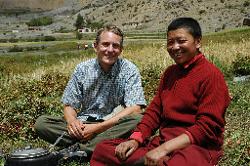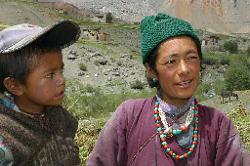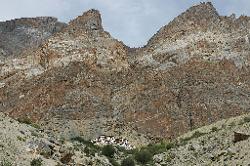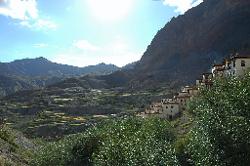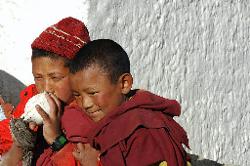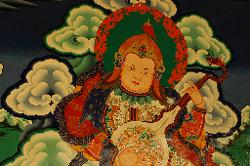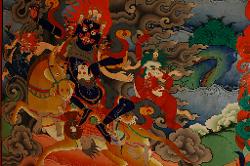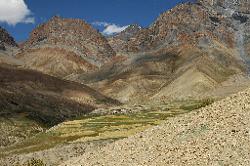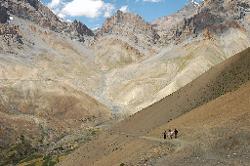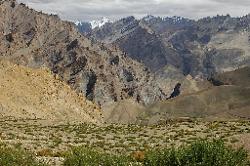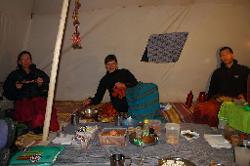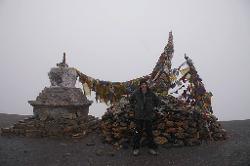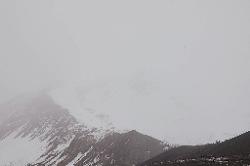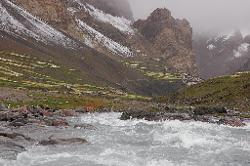MyHimalayasimpressions from |
|
|||||||

Ladakh to Zanskar: Lingshed to Photoskar
Lingshed Rest Day (Day 18)
Bad night with strange dreams and lots of coughing. After one liter of hot water with lemon, ginger and honey I start to feel better but decide to take it easy today, and reduce the planned excursions.
There's lots of clouds in the sky, and when the sun finally breaks through it creates a strangely faded orange glow on the hillsides. The clouds prevail, and there's still only little blue-coloured sky when I walk up to the monastery to attend the morning ceremony at 6.30. The monastery was founded some 500 years ago and belongs - like most monasteries in Ladakh - to the Gelugpa sect. It is one of the largest monasteries in the area, and the heli pad indicates visits by the Dalai Lama. Joel has sponsored a puja in the morning and one in the afternoon in rememberance of friends and family.
Only the older monks appear for the ritual, novices serve tea and, one hour into the ceremony, tsampa for breakfast. The sun defies the clouds, and enough light comes in through the open door and the glass-front above to reveal the beautiful assembly hall's paintings and statues. The paintings around the upper part show historic figures, part of them being covered by old thangkas.
The prayers started slowly, and are picking up intensity and strength. Occasionally they are interrupted by cymbals, bells and drums. It might appear rather monotonous, but in a way it is very relaxing to sit there and just listen and watch. It's a good time to remember the last few days and daydream, and think about loved ones at home. After nearly two hours the ceremony comes to an end.
After a spicy post-breakfast / pre-lunch instant noodle soup I walk down to the main village and stop often in barley fields where people, mostly entire families, are harvesting. Though the number of unharvested fields is large, nobody seems unduly worried or in a hurry. They are ready to take a break or have their lunch, and invite me to sit down and join them, or at least stay for a chat once they realize I speak a little Tibetan.
Despite being on the main route, the atmosphere in Lingshed is quite different from Pimo or other villages on the main trail. Is it because the village community is larger and thus the experience with ignorant tourists is more evenly distributed and makes it easier for local people to deal with it? Or is it because most tourists stay at the campsite and don't have the time or energy to walk down to the village, and those who are probably wise enough not to hand out balons or sweets.
One family is taking a break from cutting grass for winter, and prepare their lunch. They invite me to have some gyathuk, a thick soup with dough conch-shells, potatoes and spinach. They all live together in same house, the old grandmother, the attractive mother with her child and her husband. Her nun sister sometimes lives with them, sometimes in a monastery. The nun's name is Tsewang, she's in her mid-thirties and became a nun ten years ago. Her English is quite good, so we speak in whatever language we get our message across most easily. She enjoys being a nun, and also likes living in remote Lingshed. Nevertheless, she says, Leh is a great place and she likes it for shopping and eating. Eating?, I ask. Yes, she loves the variety of food she can't get here, like fruit such as bananas or apricots. Once again it hits me in the face: how spoiled are we in the west?
Barley is the staple diet, in addition to that people grow potatoes, turnip, radish and carrots. But for fruit it is definitely too high, what a contract to the Indus valley where people barely know what to do with all their apricots. In summer the nuns help their families on the fields. In winter they have time for their studies, and married women can take care of the house then without the assistance of the nuns. But being housewife is also very interesting and boring, Tsewang says; preparing food, taking care of cattle, weaving clothes. While mother and nun extend the chat, grandmother and husband are soon back to work. Their dresses are nice, like everybody else they carry a small bag matching their clothes in which they throw all the worthwhile things they find during their work, like flowers, peas, herbs.
Their house is a little further down, "the small one" they say is big enough for their 12 member family. I ask them who owns the fancy-looking house next to it and they laugh, resisting the temptation to talk bad about their neighbours I think.
It is to a large part for those moments that I come back again and again to the Himalayas. Despite all the difference between us there is still a solid common ground and understanding that makes talking, listening, learning something new so interesting, and leaves lasting impressions.
After arriving back at camp I'm ready for a nap, recovering from a cold takes quite some time during a trek. Towards evening I visit the monastery for Joel's afternoon puja. Compared to the morning ceremony, the one in the evening is taken "lightly" by the monks. Money is split between them, no instruments are used, and instead of sitting in the assembly hall they gather in the glass-covered veranda. To me it still feels like a genuine ceremony, but others not so familiar with it and with a different image of Tibetan Buddhism might be surprised by the informal behaviour of the monks.
From the helipad I watch the setting sun. The sun is actually gone behind ridges already, but its rays manage to lighten up a house and chorten while most of the valley lies in shade already. Even the rock-faces towards Hanumal La are retreating into darkness. What a wonderful play of colours. I feel somewhat sentimental having to leave this beautiful place tomorrow.
I thought I might go down to the nunnery in the evening to take up the invitation for dinner, but it's far down and I don't want to excert myself. The high fever of last night was a warning which I'd better heed, there are still some passes ahead of us.
Lingshed - Murgum La - Kiupa La - Singe La Base (Day 19)
I do feel sad to leave Lingshed after one rest day already. The clouds break up on our way up to the chortens as we head eastwards and look back into the amphitheatre where barley fields stand out against the dark red rock and the yellow hills covered by green bushes. Partridge can be heard, pika run around the rocks. I've said good-bye to Linghsed yesterday during the sunset, and don't feel too nostalgic when looking back from an unnamed pass.
We traverse to the first pass of the morning, the Mirgin La (aka Murgum La), from where we have a fine view south into Zanskar and a lively debate breaks out about our previous route and the passes. It's a scenic walk down to the pretty "village" of Skiumpata, if the two houses can really be called a village. Up the valley are more fields, belonging to Gongma. The fields are a fine contrast to the cliffs which rise behind them. An hour climb takes us zig-zagging up a steep hillside to our third pass, the Kiupa La. This translates to "the pass which makes you throw up", apparantly because of its steepness.
Puffy white clouds in the blue sky form the perfect settings for the colourful prayerflags that flatter in the wind from the chorten atop the pass; red stands for fire, blue for space, white for water, yellow for earth, green for air. Snowy ranges to the south, open space towards the north and the craggy cliffs in the east will be our companion for the rest of the afternoon. After lunch at the pass we contour along the hillsides, a constant gentle climb with great views of our past route: Singe La is hidden by a rock formation, but the steep gorge we descended to Yulchung is right behind the ridge ahead of us. After half an hour a wide valley opens below us, and lets us see down to the pretty Yulchung where we stayed a week ago. Further away, across the Zanskar gorge, are the willow trees of Nyerak, and the slope leading to the Takti La. It's a perfect afternoon with a gentle breeze, warm sunshine, and great views that evoke fond memories from the last two weeks. Colourful low bushes add extra colour to the scenery, marmots lazily retreat into their holes next to the bushes when they see me coming. The chubby animals are smart enough to realize that I'm a very slow and very lazy hiker today, and no threat.
I feel as if I could go on forever like this, but after reaching campsite at the foot of Singe La I realize that I do feel tired. And after the first cup of hot chocolate and bowl of potatoe chips I'm not willing to move.
In late afternoon the sun turns out the complicated rock formations to our left. Dark clouds on the horizon add to the dramatic scene. A light drizzle lulls me into sleep.
Singe La Base - Singe La - Photaskar (Day 20)
As it turns out, the drizzle didn't stop after I've fallen asleep, it increases. The noise, and to a lesser amount ill premonition, wake me a few times during the night. We pack in the morning under a cloudy sky, the sun almost breaking through.
On the way up to the pass, Yulchung and Nyerak appear below us through the mist. But hopes of sunshine are dashed, the closer we get to Singe La the more clouds move in. The slight drizzle turns into sleet and heavy snowflakes. The weather is even worse than on our way up from the other side two weeks ago, but nothing compared to Louise's epic day in deep snow some years ago. It looks as if Singe La has something against her, and since we're in the same group, against us. We're nice and don't hold her personally responsible :)
I head quickly down the other side, still fairly dry thanks to the silly looking umbrella. The long-awaited break at the parachute tent turns into a non-event: the owners left already so no more tea or biscuits. A father with his son on their way back to Nyerak are cooking tea in the dripping tent, and they offer to share their tea. After this short rest I continue down in the hard rain. Umbrella, raingear and walkman help to shut out the elements, though there's no protection against the stench from the decaying horse, and I'm down at the river where Kim and Lhakpa are waiting with lunch. It was a very muddy and slippery walk the last two hours. I cursed more than once. Rain has decreased but I don't feel like sitting around. Instead I jump across the creek which is much lower than before (luckily no taking-off shoes required), and follow the kitchen crew. They are not at full speed and I catch up with them.
Bumiktse La's yellow ridge is visible from far away, and gets closer much quicker than I hoped for. We stop for a few biscuits when the rain decreases. The slight drizzle makes it easier to enjoy the walk, or maybe the mind is looking for something interesting after hours of dull walking, and for the first time during the day I realize that the rain has transfored the lichen on the rocks into bright colours and also turned out the colours of the pebbles on the ground. When it rains the big scenery becomes dull, but the micro-scenery is often getting more interesting.
The village of Photoskar and its field are close now. On the long last stretch to the campsite marmots enjoy the brief break from the rain, and behave quite bold. I manage to get close for pictures; Phuntsok runs after one that has strayed too far from its hole and hops clumsily towards it. Just as Phuntsok tries to grab the cat-sized marmot, it dives into the security of its hole.
The weather seems to have confused other animals as well. A flock of long-legged egrets circles a few times above us before disappearing down the valley. Villagers from Photoskar come down the slopes with their sheep and goat. Their clothes are wet and heavy from sleet and rain, but they don't have much choice and must use every precious day before the long winter arrives.
When the horses' bells ring from the hillsides, we're relieved and put up the tents in increasing rain. An hour later I sit comfortably in my tent. Rain doesn't stop, but my things are dry, the tent seems to hold and after all it becomes a very comfortable lazy afternoon. Lying in the sleeping bag, munching Swiss chocolate and reading Mark Twain, the day doesn't seem so bad in retrospect.
Our group gets smaller: Louise has to leave tomorrow, it was great to have her on the trek. Let's hope the weather gets better for her return tomorrow. We're in no hurry, and have at least one extra day to sit out bad conditions.
|
Summary Part 6:
From the chorten above Lingshed we enjoy a last glance at the
lovely village before climbing to Murgum La and entering another
valley. Two villages appear like oases on our way to the next
pass, the very steep Kiupa La. On the traverse towards Singe La
the views open up, and we can see part of our route. Again Singe
La fosters its reputation of being a bad weather pass, snow is
falling heavily and turns into sleet further down. |
